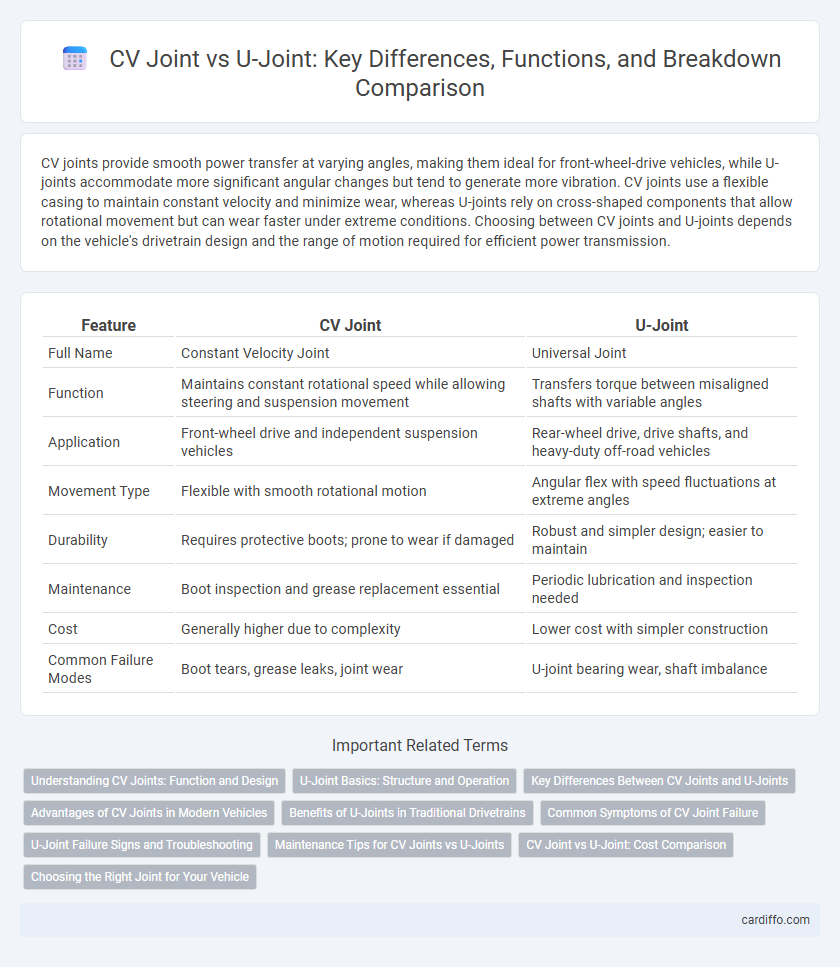CV joints provide smooth power transfer at varying angles, making them ideal for front-wheel-drive vehicles, while U-joints accommodate more significant angular changes but tend to generate more vibration. CV joints use a flexible casing to maintain constant velocity and minimize wear, whereas U-joints rely on cross-shaped components that allow rotational movement but can wear faster under extreme conditions. Choosing between CV joints and U-joints depends on the vehicle's drivetrain design and the range of motion required for efficient power transmission.
Table of Comparison
| Feature | CV Joint | U-Joint |
|---|---|---|
| Full Name | Constant Velocity Joint | Universal Joint |
| Function | Maintains constant rotational speed while allowing steering and suspension movement | Transfers torque between misaligned shafts with variable angles |
| Application | Front-wheel drive and independent suspension vehicles | Rear-wheel drive, drive shafts, and heavy-duty off-road vehicles |
| Movement Type | Flexible with smooth rotational motion | Angular flex with speed fluctuations at extreme angles |
| Durability | Requires protective boots; prone to wear if damaged | Robust and simpler design; easier to maintain |
| Maintenance | Boot inspection and grease replacement essential | Periodic lubrication and inspection needed |
| Cost | Generally higher due to complexity | Lower cost with simpler construction |
| Common Failure Modes | Boot tears, grease leaks, joint wear | U-joint bearing wear, shaft imbalance |
Understanding CV Joints: Function and Design
CV joints, or constant velocity joints, enable smooth transfer of torque while accommodating the up-and-down motion of the suspension and steering angles in front-wheel drive and all-wheel drive vehicles. Their design includes an outer race, inner race, and flexible rubber boot filled with grease to maintain lubrication and prevent contamination. By maintaining constant rotational speed regardless of shaft angle, CV joints provide efficient power delivery and reduce vibration for enhanced vehicle control.
U-Joint Basics: Structure and Operation
A U-joint, or universal joint, consists of a cross-shaped pivot connecting two rotating shafts at an angle, enabling smooth transmission of torque despite misalignment. Its structure includes bearing caps and needle bearings that allow flexible rotation while absorbing mechanical stress. This joint type is essential in drivetrains, providing durability and maintaining constant velocity in variable angles during vehicle operation.
Key Differences Between CV Joints and U-Joints
CV joints provide smooth power transfer and maintain constant velocity at various angles, essential for front-wheel-drive vehicles and independent suspension systems. U-joints enable power transmission between shafts at varying angles but can cause vibration due to speed variation and are typically used in rear-wheel-drive drivetrains. The main distinctions lie in CV joints' ability to handle complex movements without speed fluctuation, while U-joints require precise alignment to avoid wear and inefficiency.
Advantages of CV Joints in Modern Vehicles
CV joints provide constant rotational speed without significant backlash, ensuring smooth power transfer and minimizing vibrations in modern vehicles. Their flexible design accommodates a wide range of motion, which is essential for front-wheel-drive cars with independent suspension systems. This leads to improved handling, enhanced durability, and reduced maintenance compared to traditional U-joints.
Benefits of U-Joints in Traditional Drivetrains
U-joints provide superior flexibility in traditional drivetrains, allowing for smooth torque transmission even at varying angles between the driveshaft and differential. Their robust design accommodates misalignment and suspension movement, enhancing durability and reducing the risk of drivetrain failure. Compared to CV joints, U-joints are simpler, cost-effective, and easier to maintain in heavy-duty and off-road applications.
Common Symptoms of CV Joint Failure
Common symptoms of CV joint failure include a clicking or popping noise during sharp turns, especially noticeable when accelerating. Vibration or shuddering felt through the steering wheel or floorboard while driving can also indicate a worn or damaged CV joint. Grease leakage around the CV joint boot is a clear sign of boot damage, which can accelerate joint deterioration and lead to complete failure if not addressed promptly.
U-Joint Failure Signs and Troubleshooting
U-joint failure signs commonly include clunking noises during acceleration or deceleration, vibrations felt throughout the vehicle, and visible rust or corrosion on the joint. Troubleshooting involves inspecting the U-joint for excessive play, checking for worn or damaged bearings, and ensuring proper lubrication. Early detection and maintenance can prevent complete driveline failure and costly repairs.
Maintenance Tips for CV Joints vs U-Joints
Regular inspection and lubrication are essential for prolonging the lifespan of CV joints, as their rubber boots can crack and expose the joint to contaminants. U-joints require periodic greasing through grease fittings to prevent wear and avoid the risk of joint failure. Timely replacement of damaged boots on CV joints and prompt attention to any signs of vibration or noise in U-joints help maintain optimal drivetrain performance.
CV Joint vs U-Joint: Cost Comparison
CV joints generally cost more than U-joints due to their complex design and ability to handle higher articulation angles in front-wheel-drive vehicles. U-joints are simpler components commonly found in rear-wheel-drive and four-wheel-drive drivetrains, making them cheaper and easier to replace. The price difference reflects the advanced engineering of CV joints, often ranging from $50 to $150, compared to U-joints which typically cost between $20 and $60.
Choosing the Right Joint for Your Vehicle
Choosing the right joint for your vehicle depends on its design and driving demands; CV joints provide smooth, consistent power transfer ideal for front-wheel drive and independent suspension systems, while U-joints offer durability and flexibility suited for rear-wheel or four-wheel drive vehicles with solid axles. Consider the driving environment--CV joints excel in maintaining constant velocity at variable angles, minimizing vibration during turns, whereas U-joints accommodate larger angles but may cause more vibration at high speeds. Prioritizing joint compatibility with your vehicle's drivetrain ensures optimal performance, longevity, and breakdown prevention.
CV joint vs U-joint Infographic

 cardiffo.com
cardiffo.com